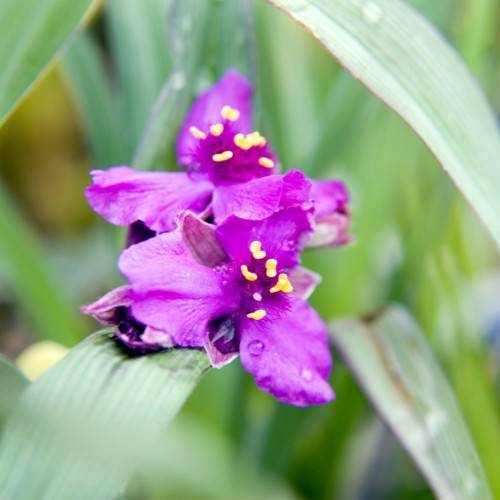
spiderwort
Tradescantia (Andersoniana Group) 'Concord Grape'
Cycle:
Herbaceous Perennial
Watering:
Average
Hardiness Zone:
4 - 7
Flowers:
Flowers
Sun:
full sun,part shade
Leaf:
Yes
Growth Rate:
Low
Maintenance:
Moderate
Drought Tolerant:
Yes
Indoors:
Yes
Care Level:
Moderate
watering
Spiderwort (Tradescantia (Andersoniana Group) 'Concord Grape') should be watered regularly but not excessively. During the growing season (spring through summer), water the plant deeply and slowly at least once per week, making sure the soil is evenly moist. It is important to not let the soil dry out as spiderwort is not drought tolerant. If the weather is extremely hot or windy, the plant may need extra watering. During the winter, water the plant only occasionally, allowing the soil to dry out slightly between waterings. Avoid getting the leaves wet so as to not encourage rot.
sunlight
Spiderwort (Tradescantia (Andersoniana Group) 'Concord Grape') prefers full sun, meaning it should receive direct sunlight for at least 6-8 hours per day. It is best to keep the plant in a spot where it receives direct light for most of the morning and early afternoon, with some filtered light or partial shade in the afternoon before sundown.
pruning
Pruning of spiderwort should begin when the plant is young and should be done throughout the year. Pruning should focus on removing damaged, diseased, or dead foliage or stems and should also be done to shape the plant. During the growing season, it is best to prune back the stems to create a dense, bushy form. This should be done by cutting the stems back to a pair of healthy leaves and removing any of the flowers and seed heads. Pruning can be done as much as once a month during the summer growing season, though it is not necessary to do it that often. In the fall and winter, less pruning should be done to allow the plant to go dormant during the cold months. It is also important to note that spider wort can spread quickly and should be monitored and controlled by pruning or division when needed.
Season
Hardiness Map
FAQ
Do spiderwort plants require a specific soil type?
Spiderwort plants generally grow best in soils that are rich in organic matter and have good drainage. Sandy soils with a pH of 6-7 and plenty of added compost or manure are ideal for spiderwort. Spiderwort can tolerate poor soils, but optimal growth will be achieved in softer, loamy soils with more organic content. It is important to avoid overly wet soils as this can cause root rot or other problems with the plant.
Do spiderwort plants have any unique growth patterns?
Spiderwort plants have a unique growth pattern, called "spiderlings," where many small, baby-like plants grow out of the stems, just above the soil line. As the baby plants get bigger, they drop off and take root on their own. This helps the parent plant spread and propagate quickly and easily. Spiderworts also have pointed leaves with veins that run in a web-like pattern which is quite unique.
Are spiderwort flowers fragrant?
No, spiderwort flowers are not typically fragrant. The flowers have a small, star-like shape and can be found in a variety of colors, including purple, white and lavender. The flowers are known for their long-lasting beauty, but are not typically considered to be fragrant.
Could spiderwort be used as a border plant in a garden?
Yes, spiderwort can be used as a border plant in a garden. These bright and vibrant plants make ideal borders because they can grow up to two feet in height and have a mound-like shape. Additionally, when the purplish-blue flowers bloom, they create a stunning effect that attracts pollinators and beautifies any garden. Spiderwort is also known to be a hardy plant that can tolerate a range of soil and lighting conditions, which makes it an ideal choice for garden borders.
Could spiderwort be grown as a houseplant?
Yes, spiderwort is a great option for a houseplant! Spiderwort is a tiny, low-maintenance perennial that is native to North America. It has small clusters of three-petaled flowers that come in various shades of blue, purple, pink, and white. This plant grows quickly and has the potential to bloom multiple times throughout the year when given the right environment. It can easily be grown as an indoor houseplant with shallow pots, a bright location, and moist soil. With proper care, spiderwort will happily add a pop of color and texture to any indoor room or office space.
Do spiderwort plants spread rapidly?
Yes, spiderwort plants spread rapidly. They are considered to be somewhat invasive and are capable of quickly taking over an area. The flowers of the spiderwort plant can self-pollinate, creating more flowers and more seeds, which helps the plant spread. Spiderwort plant roots also help it spread by growing deeper than those of regular plants, allowing them to capture nutrients from further down in the soil. Additionally, the spiderwort plant spreads through rhizomes, which is an underground stem that sends up shoots above the ground. All of these mechanisms combined make spiderwort a very fast spreading plant.
Is spiderwort suitable for rooftop gardens?
Yes, spiderwort is suitable for rooftop gardens because it is drought tolerant and easily adaptable to a wide range of soil types. It grows best in partial shade, does not require much fertilizer or maintenance, and is tolerant of cold temperatures. Spiderwort is also a low-maintenance flowering plant, meaning it will add color and interest to a rooftop garden with minimal effort required.
